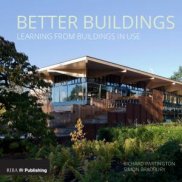Better Buildings: Learning from buildings in use - review
Richard Partington & Simon Bradbury - 'Better Buildings: Learning from buildings in use'
RIBA Publishing (Mar 2017)
This book takes as its foundation the general acceptance that architects rarely return to the buildings they design to assess their performance-in-use. This is despite the demand for energy efficient design steadily increasing.
The authors believe a vital part of the architect’s role is talking to users, observing how the buildings work and have been adapted, and assessing whether the environments they have created are actually enjoyable places to live and work.
‘Better Buildings’ is a fully-revised edition of a 2007 book ‘Sustainable Architecture’, which postulated that spirits could be lifted as well as the planet being saved by building design that adhered to sustainable principles. By stepping further with this new book, and examining the methods that can be used to observe how sustainable buildings work in occupation, the authors provide architects with the necessary inspiration and tools to deliver better sustainable design.
The authors address the widely-held perception that there are barriers to undertaking effective follow-through after handover; providing ideas and strategies for overcoming problems in practice.
The book is divided into two sections, starting with a selection of short essays provided by industry thought-leaders such as Bill Gething (who has written extensively on the subject in books like ‘Design for Climate Change’), and Mark Lumley of Architype.
The second section provides a series of illustrated case studies of aesthetically-attractive and environmentally ground-breaking projects, such as the Woodland Trust HQ in Grantham, and WWF’s Living Planet Centre in Woking. In each it explores how the architectural design solutions delivered the low-energy performance promised, providing accounts that are also honest about where they fell short.
The book does not prescribe one particular method over any other, instead it seeks to examine the balance that designers have sought between technical surety and formal invention.
Overall, it is a well-presented and comprehensive book, which joins the growing corpus of titles examining this vital area of the industry. Students and professionals would do well to check it out.
[edit] Related articles on Designing Buildings
- An Introduction to Passive House - review.
- Bill Gething and Katie Puckett - Design for Climate Change.
- Building performance evaluation.
- Building Revolutions - review.
- Closing the gap between design and as-built performance.
- FutuREstorative - review.
- Performance in use.
- The building as climate modifier.
Featured articles and news
RTPI leader to become new CIOB Chief Executive Officer
Dr Victoria Hills MRTPI, FICE to take over after Caroline Gumble’s departure.
Social and affordable housing, a long term plan for delivery
The “Delivering a Decade of Renewal for Social and Affordable Housing” strategy sets out future path.
A change to adoptive architecture
Effects of global weather warming on architectural detailing, material choice and human interaction.
The proposed publicly owned and backed subsidiary of Homes England, to facilitate new homes.
How big is the problem and what can we do to mitigate the effects?
Overheating guidance and tools for building designers
A number of cool guides to help with the heat.
The UK's Modern Industrial Strategy: A 10 year plan
Previous consultation criticism, current key elements and general support with some persisting reservations.
Building Safety Regulator reforms
New roles, new staff and a new fast track service pave the way for a single construction regulator.
Architectural Technologist CPDs and Communications
CIAT CPD… and how you can do it!
Cooling centres and cool spaces
Managing extreme heat in cities by directing the public to places for heat stress relief and water sources.
Winter gardens: A brief history and warm variations
Extending the season with glass in different forms and terms.
Restoring Great Yarmouth's Winter Gardens
Transforming one of the least sustainable constructions imaginable.
Construction Skills Mission Board launch sector drive
Newly formed government and industry collaboration set strategy for recruiting an additional 100,000 construction workers a year.
New Architects Code comes into effect in September 2025
ARB Architects Code of Conduct and Practice available with ongoing consultation regarding guidance.
Welsh Skills Body (Medr) launches ambitious plan
The new skills body brings together funding and regulation of tertiary education and research for the devolved nation.
Paul Gandy FCIOB announced as next CIOB President
Former Tilbury Douglas CEO takes helm.
UK Infrastructure: A 10 Year Strategy. In brief with reactions
With the National Infrastructure and Service Transformation Authority (NISTA).























